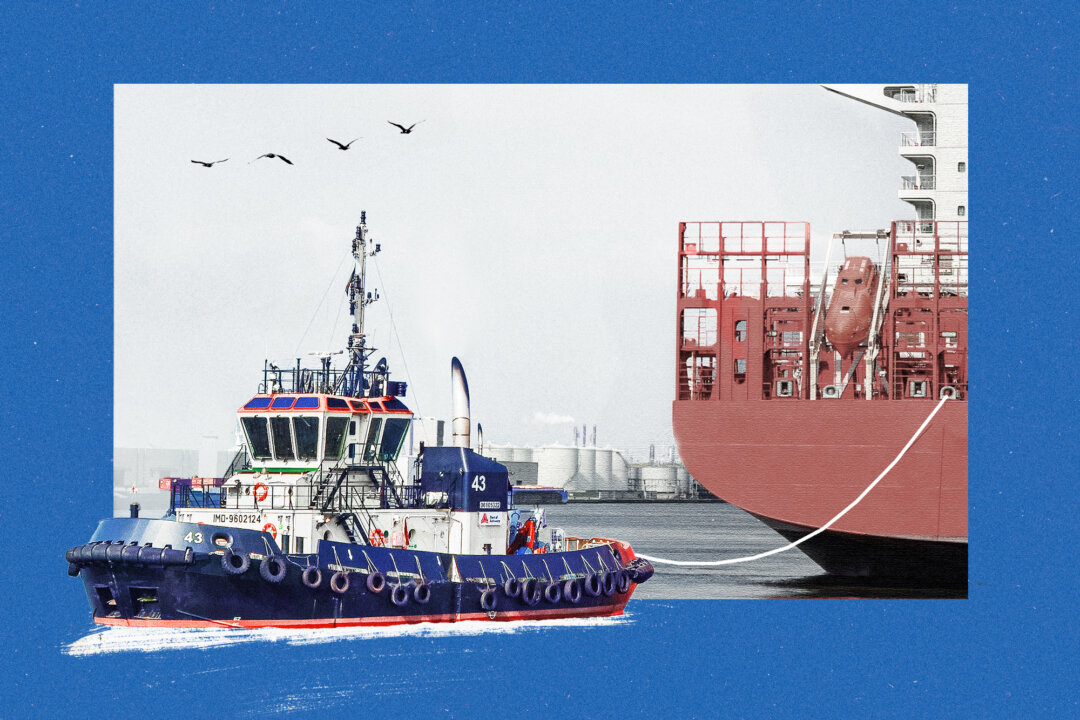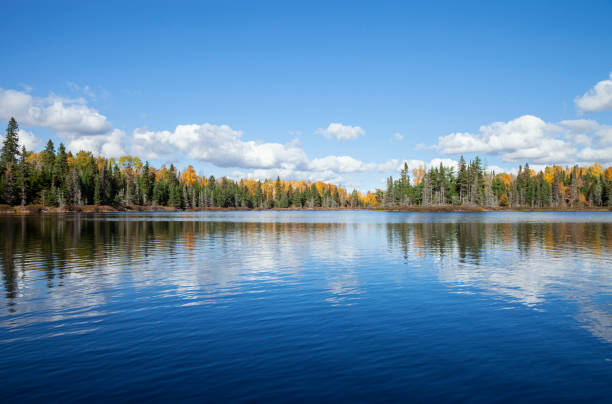


OAKLAND, Calif.—The Fishing Creek’s 3,000 units of horsepower is generated by twin Caterpillar 3512 main engines, enabling it to effectively push, pull, and maneuver barges and cargo ships weighing tens of thousands of tons.
The tugboat, a 94-foot floating powerhouse built in 2017, is docked securely in Alameda port harbor; it’s part of Vane Brothers’ nationwide fleet of 50 tugboats and 80 barges.
“It’s the same thing with every ship that comes in from any port in the country—they require tugboats,” says Max Rosenberg, the company’s California port engineer.
“Tugboats help them to dock. Without the tugboats, it would definitely increase the risk of collisions, all sorts of accidents—groundings,” Rosenberg told The Epoch Times.
Founded in 1898 by Capt. William Burke Vane and his brother, Capt. Allen Vane, the Vane Brothers fleet serves various port locations across the country, including the Port of San Francisco and the Port of Los Angeles/Long Beach.
Now the fleet’s future in California may be in jeopardy, due to costly new emissions rules.
In 1998, the EPA launched a four-tier program to reduce diesel emissions by up to 67 percent over a decade.
In 2001, the agency introduced Tier 2, targeting greenhouse gas emissions from diesel engines. Tier 3 regulations were implemented gradually between 2006 and 2008 to further improve emissions control.
Premium Picks
The EPA began implementing Tier 4 standards for most diesel engines in 2008. Tier 4 standards are the strictest and mandate a reduction of up to 90 percent in emissions of particulate matter and nitrogen oxides.
Long phase-in periods and hardship extensions mean that most existing boats aren’t up to standard yet.
Now California maritime operators have an extra burden—the California Air Resources Board (CARB) is seeking to reduce emissions even further, beyond the federal standard.
In 2022, CARB amended its 2008 Commercial Harbor Craft rule, significantly broadening the type of vessels subject to the requirements and expediting the transition to Tier 3, 4, or zero-emission engines.
“CARB is proposing a performance standard cleaner than Tier 4,” the agency said.
Last year, the agency expanded the commercial harbor craft rule once again, imposing stricter emissions standards for boats including ferries, tugboats, and other commercial workboats.

Under the amendment, effective Dec. 31, 2024, affected vessels must have Tier 3 or 4 engines and must include diesel particulate filters.
There’s one problem: diesel particulate filters, while standard equipment in new cars and trucks, are not currently available for the diesel engines found in most commercial marine vessels.
The amendment stipulates that once diesel particulate filters are commercially available for affected marine vessels, owners will have six months to adopt them.
Cost of Compliance
Members of the maritime industry have generally supported initiatives aimed at improving air quality in California, however, many believe the new commercial harbor craft rule is overly stringent and enormously expensive.Although diesel particulate filter technology is not available for most marine diesel engines, existing vessels must nonetheless be ready to accommodate the filters. That means retrofitting each vessel, at an estimated cost of up to $5 million per boat.
Rosenberg said the rule puts the cart before the horse, by creating financial challenges for maritime companies to comply with air quality regulations when the necessary equipment is largely unavailable for commercial watercraft.
Fleets based in California are uncertain about how the system will integrate with their engines—and as Rosenberg noted, there is no example to follow.
William Suwaed, chief engineer with Vane Brothers aboard the Fishing Creek, told The Epoch Times that transitioning to the new filtration system will be a “big change.”
“And, like Max says, a lot of money,” Suwaed said. “We will need to adjust and change many things on the boat. We can keep the hard horsepower, which is a very critical thing for us, pushing barges and fuel.
“But, it’s good for the environment,” Suwaed added, “and it’s good for the city. And that’s what also matters to us.”
Rick Iuliucci, the vice president of operations at Vane Brothers, said that Tier 4 diesel particulate filter compliance is where “the rubber meets the road.”

“It would be like me telling you to buy a car now [and then] put in a bigger engine three years later” while not knowing how it would look or operate, Iuliucci said.
“How am I going to do that? A tugboat is a finite space,” he said.
Tugboats are already cleaner than other forms of commercial transportation, Iuliucci added. However, CARB has established an exceptionally high standard for greenhouse gas emissions.
Reducing Emissions
Despite the cost, CARB believes that diesel particulate filter systems for commercial harbor craft are a worthwhile investment. The board says that the systems would significantly reduce cancer risk for more than 22 million residents living along the coast and up to 50 miles inland.In a March, 2022 statement, CARB noted that many harbor vessels still utilize older Tier 2 engine technology, which emits 162 times more diesel particulate matter than a five-year-old school bus.
“Emissions from harbor craft contribute to toxic diesel emissions from coastal and port activities,” said board chair Liane Randolph.
“These amendments will help clean the air and protect public health, especially in port-adjacent communities that are already burdened by high levels of air pollution,” she said.
The board estimates that its regulatory changes will lead to more than $5 billion in health care cost savings, in addition to meeting federal air quality standards.
CARB said its objective is to reduce diesel particulate emissions up to 89 percent by 2035.
Citing California’s “unique” air quality challenges, CARB said it considers all emission sources that directly impact health in communities. The rules for commercial harbor craft are no exception.
“CARB’s rule-making process for the [commercial harbor craft] regulation was very robust and included an extensive cost and economic analysis, which identified the costs associated with compliance, as well as a public health impact assessment,” the board stated in an email to The Epoch Times.

Fire Hazards
Trade association American Waterways Operators (AWO) opposes the amended rule. With more than 300 member companies, the AWO represents the U.S. tugboat, towboat, and barge industry.In a letter dated Oct. 23, 2024, the AWO and several other commercial maritime organizations urged the EPA administrator to reject CARB’s request for authorization to enforce the new rule changes.
“As our organizations have repeatedly reiterated to CARB, existing DPF [diesel particulate filter] technology is not feasible and has not been demonstrated to be safe for commercial harbor craft,” the letter stated.
Diesel particulate filters are large ceramic filters that collect particulate matter from diesel exhaust. Once the filter is full, it undergoes a process called “regeneration,” during which the particulate matter, or soot, is burned at extremely high temperatures.
This regeneration process can be either active or passive.
Passive regeneration diverts power from engine propulsion to remove the particles, while in active regeneration, the filter utilizes a burner or another external heat source to eliminate the particulate matter.
The joint letter stated that both processes pose “serious risks” to waterway safety, noting that particulate filters with active regeneration have caused “horrific” fires in the trucking industry.
“While any fire emergency is serious, a vessel fire on water is much more dangerous than a truck fire on land. A truck driver can exit the vehicle and run from the danger.”
The situation is different with tugboats, Rosenberg said.
“In our case, if we have a tugboat fire offshore, our mariners go from being sailors to being firefighters. They don’t have the option to pull over and get out,” he told The Epoch Times.
U.S. Coast Guard Rear Admiral Andrew Sugimoto highlighted potential fire safety concerns in a February 2024 letter to CARB Branch Chief Bonnie Soriano.
While the Coast Guard enforces navigation laws and regulations regarding marine safety; Sugimoto said, it “will not enforce California’s CHC [commercial harbor craft] Regulation.”

‘Unproductive’ Costs
CARB noted that specific programs, exemptions, and extensions exist for maritime companies seeking compliance.AWO President and CEO Jennifer Carpenter said there’s one caveat: compliance requires maritime companies to invest thousands of dollars in engineering and related costs to demonstrate their commitment.
“So you have to spend all of this money to prove that you can’t do something,” she said.
“These costs are totally unproductive.”
Founded in 1997 by Capt. Martin Curtin, a tugboat operator, Curtin Maritime in Long Beach is another maritime solutions provider affected by the new CARB emissions rule.
The company operates a large fleet including tugboats, supply vessels, barges, dump scows, and derrick cranes.
Chase Henderson, the company’s vice president of operations, expressed confidence that the company’s machine repower team will ensure that the vessels comply with emissions regulations.
“With that said, the cost of some of these new Tier 4 engines is more than double their Tier 2 or 3 predecessors,” Henderson told The Epoch Times.
“We’re seeing fewer grants for [upgrades] now than there were in years past, so the financial burden of doing these repowers is on us—and it is massive.”
“We’re removing solid, proven, reliable engines and replacing [them] with new Tier 4 technology that, in many cases, the engine manufacturer’s technicians don’t even know how to repair,” Henderson said.
“These new engines generate extreme heat, are all electronic, require a laptop and software to troubleshoot, and in many cases burn substantially more fuel than the previous engines.”

State Legislation
With fire safety in mind, last August, California’s Legislature passed Assembly Bill 1122, which mandated the installation of an emergency override or bypass safety system on diesel particulate filters used in commercial harbor craft.The legislation would also have postponed the CARB requirement to either install a new Tier 4 engine or retrofit an existing engine in designated harbor craft.
California Gov. Gavin Newsom vetoed the legislation on Sept. 29, 2024, stating that the bill would delay compliance with CARB’s harbor craft regulation.
In 2020, Newsom signed an executive order directing CARB to create strategies for transitioning to 100-percent zero-emission off-road vehicles and equipment by 2035.
The governor said that AB1122 “undermines this balance and jeopardizes our clean air goals.”
“While I recognize the challenges and concerns of adopting new technologies and approaches, Calfornians deserve and benefit from clean air and from the avoidance of greenhouse gas emissions that contribute to our rapidly changing climate,” the governor said.
Newsom urged maritime operators in California to comply with the new regulation and to collaborate with CARB to explore alternative compliance solutions if they face “insurmountable challenges.”
Although there was broad legislative and industry support for the bill, Carpenter said that the governor vetoed it.
“Who’s best positioned to fix this? It is the governor of California,” she said.

‘Self-Inflicted’ Crisis
Carpenter said that the new commercial harbor craft rule is not merely a burdensome regulation.“It is a self-inflicted supply chain crisis in the making, which is what’s so frustrating about this,” Carpenter told The Epoch Times.
While the new rule is fundamentally a good faith effort, Carpenter said, it represents a flawed attempt to further reduce emissions based on overly optimistic assumptions about technology that has not yet been developed or certified as safe for maritime use.
In a letter dated Jan. 30 to Newsom, Carpenter requested the withdrawal of the 2022 amendments to the commercial harbor craft rule.
“California boasts one of the nation’s most economically prosperous ports and is critical to the national and global supply chain,” she said in the letter.
She feels that CARB has shifted its air-quality focus to commercial harbor craft while exempting trains and semi-trucks.
On Jan. 13, a week before President Joe Biden left office, CARB withdrew its request for federal approval to implement stricter emissions regulations for diesel locomotives and semi-trucks.
“This decision to withdraw emissions rules with the exception of those for the maritime industry places vessel operators at a competitive disadvantage,” Carpenter said.
Such an imbalance could “cripple” California’s marine sector and economy and threaten both mariner safety and the environment, she said.
Supply Chain Impact
California boasts three of the top 10 busiest container ports in the United States. They act as a vital global gateway for agricultural goods, vehicles, energy products, and other cargo.The commercial harbor craft industry transports more than 665 million tons of cargo annually, emitting 43 percent less greenhouse gas than rail and 832 percent less than trucks, Carpenter said.

California’s maritime industry supports more than 50,000 jobs and generates $12.2 billion in economic activity, according to Carpenter.
However, the commercial harbor craft rule and its associated costs—$5 million retrofits, “risky” diesel particulate filter systems—could negatively impact these figures.
Carpenter said that the retrofit estimate assumes that harbor craft owners possess the necessary finances to modify each vessel. Smaller operations would be significantly impacted, she said.
CARB reported that as of 2021, there were 229 towing vessels in California, including escort/ship assist tugs, push/tow tugs, and specially designed pusher tugs known as articulated tug barges.
Iuliucci warned that costs associated with the commercial harbor craft rule might drive maritime companies away from California, drastically reducing the number of available towing vessels and leaving a hole in the supply chain.
“We’re confronted by a much more challenging choice, which is to try and comply,” Iuliucci said. “If you can’t buy what’s mandated, how can you do this?”
“There’s just a lack of understanding [at the state level] about how the American supply chain works. There is resistance to cooperating with an industry that is trying to make improvements. It’s frustrating.”
Henderson remains optimistic that diesel engine technology will improve and that operating costs will eventually decrease.
He said that the company is committed to staying in California and adhering to the state’s continuously evolving air quality regulations.
Although the regulations may be subject to alterations and occasional delays, Henderson said, “They’re never going away.”
Iuliucci, on the other hand, isn’t as upbeat about Vane Brothers’s future in California.
“We have choices to make,” he said. “Do we want to continue to operate in California? If I have to make this type of investment in my fleet of boats in California, I have to pass that on. I can’t support that.”










